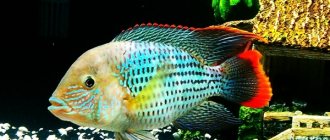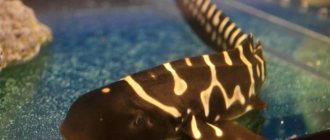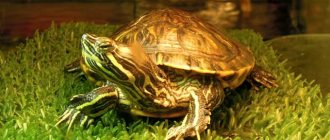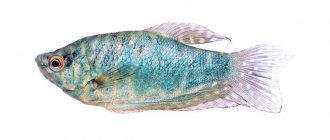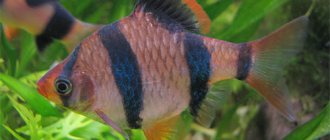Habitat in nature
The cherry barb (Barbus titteya) was first described in 1929. Its homeland is in Asia, in the Kelani and Nilwala rivers in Sri Lanka. There are also several introduced populations in Colombia and Mexico.
The species is listed in the Red Book as a species under surveillance. In the years from 1988 to 1994, it was classified as a threatened species, but the crisis has now passed.
Inhabits shaded streams and rivers of the plains of Sri Lanka. Prefers places with slow currents or standing water, and a bottom covered with fallen leaves and branches.
In nature it feeds on insects, larvae and detritus.
How to effectively organize reproduction?
According to the work of Sundarabarathy et al., 2004, in captivity, cherry barbs were successfully bred only in a flow system. Researchers collected mature males and females from a stream in the village of Ambagamuwa, Ginigatena district, Sri Lanka. To create a broodstock, females were selected from which, when gently pressing on the abdomen, eggs with a yolk appeared.
Producers were planted in specially constructed concrete containers (90x50x60 cm3), located in the shade and below the water level in the pond. From the pond, water continuously flowed into the containers and then went into the drain. In addition to the duct, unsuccessful attempts have also been made to breed in indoor and outdoor pools.
Table 1. Water parameters in three cultivation systems
| Options | Duct | Indoor pools | Outdoor pool |
| pH | 7.9±1.5 | 7.9±1.2 | 7.6±1.0 |
| TDS (mg/l) | 199.8±78.54 | 77.2±5.9 | 75.7±6.4 |
| Electrical conductivity (µS) | 345.7±84.21 | 119.6±8.9 | 110.4±5.2 |
| Dissolved O2 (mg/l) | 7.9±1.2 | 9.1±1.6 | 8.0±2.7 |
| Temperature (°C) | 25.3±2.7 | 24.8±0.2 | 26.4±1.2 |
It has been shown that for the reproduction of wild individuals, the creation of a flow-type cultivation system, i.e., is of key importance. with constant changes in dissolved oxygen concentration, water conductivity and flow. Specific parameters such as current strength, dissolved oxygen concentration, or electrical conductivity could also influence breeding success.
However, in captivity, the fish spawned 5 times a year, and this event was not tied to the time of year. It can be assumed that the barb breeds all year round.
At a water temperature of 26-28°C, Puntius titteya reaches sexual maturity at 150-210 days. By 180-210 days, females have mature eggs with a yolk, and in males, by 150-180 days, a red color is formed, especially on the fins. Adult individuals have a length of 4.7±0.61 cm, weight - 1.24±0.47 grams, gonad mass - 0.16±0.12 grams.
We suggest you read: How to give Etamzilat to a cat
Cherry barbs are spawning fish, and if kept properly, breeding them is not difficult. For spawning, a separate aquarium is used, which has dim lighting, otherwise the fish will immediately eat their eggs. For spawning, it is necessary to place a skein of nylon threads into the reservoir, on which the eggs will be attached.
For reproduction, choose mature, strong individuals.
The larvae appear 2 days after spawning, and after another 24 hours they begin to swim. At this moment they begin to feed them. For this purpose live dust is used. As the fry grow, they are transferred to larger live food. If everything is fine with the young animals, they develop and grow quickly. Having become comfortable in the aquarium, the fry actively swim, not being afraid of the approach of a person.
In the period preceding spawning, it is useful to feed the fish with protein foods and keep them in water with a temperature of 26-27o. Three to four days before the process itself, it is recommended to keep male and female individuals separately. Considering the capabilities of modern aquarium keeping, the question “barbs: reproduction?” is not complicated.
The spawning tank is a small aquarium with a water height of up to 20 cm. A separator net is placed on its bottom or plants are planted - small bushes firmly attached to the bottom. This is a place to place future eggs. It should completely eliminate mechanical damage and provide free access to oxygen dissolved in water.
At the time of transplanting the offspring into the spawning tank, the water temperature in it should not differ much from the previous water home. Light is not needed in such an aquarium. On the contrary, it is extinguished, leaving romantic couples in twilight.
The next morning, small whitish grains become noticeable. These are eggs that in the first two or three days bear little resemblance to fry. Over time, the eggs hatch and turn into offspring. The fry are fed with special food or finely ground natural products.
Male (bottom) and female (top)
The cherry barb is a spawning fish that does not care about the fry and can even eat them. Therefore, the fry need to sleep, for which the easiest way is to transplant the fish into a separate spawning aquarium during the spawning period. Its volume should be from 15 liters, the water temperature should be 2-3 degrees higher, and the illumination should be slightly weaker; the presence of plants is a must.
Two weeks before spawning, males are separated and fed generously with live food with the addition of plant foods. For spawning, you can plant a couple of fish or a group with a predominance of males. Typically the male-female ratio is 2:1. The female is first released into the spawning area, and after about two hours the males are released.
Reproduction of cherry barbs begins early in the morning. Females lay eggs on plants, and males fertilize them. During spawning, the female can lay 150-300 eggs. Immediately after spawning, cherry barbs should be removed to a general aquarium, and the eggs should be left in the fish tank. Fish eggs stuck to the leaves are not touched, but those that have fallen to the bottom are mistaken for food. Therefore, it is better to lay a protective net on the bottom of the aquarium.
The fry emerge from the eggs after 1-2 days, and a day later they begin to swim. The optimal complementary food for young animals at first is ciliates; later, you can diversify the diet with microworms and artemia nauplii. Gradually you need to lower the water temperature and move the young animals to a larger aquarium.
| basic information | |
| Name | Cherry barb |
| Scientific name | Puntius titteya |
| Origin | Sri Lanka |
| Maximum size | 40-50mm |
| Minimum aquarium size | 20l |
| Water parameters | Temperature: 20-27°C pH: 6.0-8.0 Water hardness: Above average |
| Nutrition | Omnivore |
| Behavior and Compatibility | Peaceful fish, not recommended to be kept with predators. |
Description
Torpedo-shaped body with small fins and a forked tail. The fish is small in size, the maximum body length of which is 5 cm, usually less.
The average life expectancy is 4 years, but with proper care it can live more than 6 years.
The body color is dark red and brownish in the normal state, but during excitement or spawning, the males become a bright cherry color, almost scarlet.
There is also a dark stripe running along the body, but not continuous, but in separate spots.
Description of the barb
The cherry barb will look great in a general aquarium. It will become a real decoration of any artificial reservoir. And its unpretentiousness and high adaptability will be a godsend for any aquarium owner.
The size of the fish is small - up to 5 cm. Their body is similar to a torpedo, which is important for swimming speed. The pectoral and ventral fins are small, and the caudal fin is forked. Along the spine there is an intermittent spotted stripe of dark color. The color of the female is calmer, while the male is very bright, and during the spawning period his color is almost scarlet.
Cherry barb grows up to 5cm in length
The quality of care and nutrition affect their life expectancy. On average they live about 5 years. But under favorable conditions they can live up to 6 or even 7 years.
Breeding the cherry barb is not difficult, so beginners are advised to start their experience by breeding this particular species.
Difficulty in content
A fairly unpretentious fish that gets along with all peaceful fish.
However, it requires a well-kept aquarium with stable parameters and clean water.
If you have such an aquarium, then there should be no problems with maintenance.
It can be recommended to every aquarist, even beginners. Peaceful, gets along with any fish, unpretentious and quite easy to breed.
Like most barbs, the cherry barb is an active and lively fish that looks great in a community aquarium. It is best to keep it in a school, and choose the same small and active fish as neighbors.
They are a little timid and like to stay in the shade of plants, so it is important that there are plenty of places in the aquarium where they can hide.
Who do cherry barbs get along with?
Not all representatives of the species have a peaceful disposition, but this does not apply to cherry fish. They are quite docile and peaceful, they can get along with other inhabitants and do not even try to pluck their veiled neighbors. Cherry barbs can be kept in a community aquarium, but only with equally small and non-aggressive fish.
Predatory representatives of the underwater world will consider these bright and agile fish only as food. You can choose neighbors for cherry barbs from the following representatives:
- ordinary neons, black or red;
- erythrozonus;
- rasbory.
They get along well with various crustaceans and even small cherry shrimp.
Feeding
Feeding is quite simple. The main rule is to feed him a variety of foods; he is not picky about food; he eats live, frozen and artificial food.
It is ideal to feed him two to three times a day, in small portions that he can eat in two to three minutes. With varied, regular feeding, the barb will always be active and beautiful.
When choosing food, keep in mind that the cherry cat has a very small mouth and the food should be small. He especially loves bloodworms and tubifex, but will not refuse other live foods.
Breeding
It is very easy to distinguish a male from a female: males are slimmer and have an intense red color, which becomes brighter during spawning. The abdomen of females is round, full, and their coloring is more modest.
Under good conditions, cherry barbs can spawn in a community aquarium without any care from the owner, but in this case, most of the offspring will be eaten by the parents and other inhabitants.
To increase the survival rate of fry, it is necessary to resort to the help of a spawning tank - a small container isolated from other inhabitants. In such conditions, it becomes possible to control spawning.
The spawning tank should be dimly lit, and its bottom should be lined with substrate:
- rug imitating vegetation;
- layer of glass beads;
- living plants with small foliage: pinnate, moss, hornwort, etc.
A separator net is placed on top of them, the mesh of which should be large enough for the eggs to fall into it, but at the same time not allow the parents to reach the eggs. The optimal temperature for spawning is 26 ° C, and the water should be soft, neutral or sour. It is recommended to install a filter and aerator.
Before spawning, producers are advised to increase the proportion of high-protein live or frozen food in the diet, as well as increase water changes.
Sexual differences in cherry barbs. On top is a male with a bright ruby color, and below is a female, her coloring is somewhat more modest.
A small group of the brightest and largest fish is deposited in the spawning tank. As soon as eggs form in the abdomens of the females, the barbs split into pairs and begin spawning, which begins early in the morning. The female lays eggs on the substrate, which are immediately fertilized by the male. After spawning, the spawners must be removed as soon as possible, otherwise they may eat the eggs.
Incubation of eggs lasts 24-48 hours, depending on the water temperature. For the first 24 hours, the larvae feed from the yolk sac, after which they begin to swim around the aquarium in search of food. At this time, you need to start feeding them with grated yolk or “live dust”, and after a few days you can offer them food of a larger fraction - artemia and cyclops nauplii or microworms.
There is no need to limit the fry's food. Feeding should be organized 4-6 times a day in small portions. Remains of food should be removed an hour after feeding, and water changes should be small - about 10%, and frequent - up to 4 times a week.
Keeping in an aquarium
Quite an active fish that spends all its time in motion. This means there should be enough free space in the aquarium, but also a lot of plants, in the shade of which barbs like to hide.
A small aquarium is suitable for keeping, 50 liters for a flock of 10 fish.
Regular water changes and filtration are required. Filtration produces a slight current, which stimulates the fish to be active and resembles their native environment.
It is important to remember that this is a schooling fish, and it should be kept in a school of 7-10 pieces. If you keep less than 5, then the fish is in a state of stress, which affects its color and life expectancy.
And to make him feel even more comfortable, you need to plant the aquarium with plants. Living plants, diffused light and dark soil are the environment in which it lives in nature.
Ideal parameters for keeping will be: temperature 23-26C, ph: 6.5-7.0, 2 - 18 dGH.
Reproduction
Cherry barbs are spawning fish, and if kept properly, breeding them is not difficult. For spawning, a separate aquarium is used, which has dim lighting, otherwise the fish will immediately eat their eggs. For spawning, it is necessary to place a skein of nylon threads into the reservoir, on which the eggs will be attached. It is optimal to plant only a pair that is ready for reproduction. After the eggs are spawned, the adults are removed. On average, one female lays about 200 eggs. At best, 65% of the fry survive to adulthood, even with proper rearing.
For reproduction, choose mature, strong individuals.
The larvae appear 2 days after spawning, and after another 24 hours they begin to swim. At this moment they begin to feed them. For this purpose live dust is used. As the fry grow, they are transferred to larger live food. If everything is fine with the young animals, they develop and grow quickly. Having become comfortable in the aquarium, the fry actively swim, not being afraid of the approach of a person.
Breeding the cherry barb is the simplest in comparison with breeding other spawning fish.
Compatibility
Unlike many of its relatives, the cherry barb is a very peaceful and calm fish in behavior. They don't even bother fish with veil fins.
Ideal for community aquariums, but must be kept with similarly small fish. Small and defenseless, it will become easy prey for predatory fish.
It is good to keep it with tetras - common neon, red neon, erythrozonus, black neon. They get along well with small fish, such as rasbora, but angelfish are quite large and aggressive neighbors for them.
However, he himself will not touch them, but they can touch him. They also do not touch shrimp, even small ones like cherry shrimp.
Content
This tiny fish is unpretentious in keeping and requires small aquarium volumes, but in order for it to truly shine, it is necessary to create conditions for it that are as close to natural as possible:
- Cherry barbs feel comfortable in a group of 5 or more individuals, and the best option would be a flock of 6-10 tails.
- For a large group of 10 individuals, you will need an aquarium of at least 50 liters.
- Red males look most impressive against the backdrop of lush green vegetation, to which they are very loyal, so this type of fish can be recommended for keeping in herbal gardens.
- You can choose any soil, but the color looks most vibrant against a dark background.
- Reservoirs of tropical forests have dim lighting, so dim, diffused light is preferable for cherry barbs. Introduce floating plants and driftwood into the aquarium, which will not only create shaded areas, but also give it a natural look.
- A base of dried and scalded oak, almond and birch leaves will soften the water, enrich it with tannins, which have a beneficial effect on the immunity of fish and serve as a substrate for beneficial microorganisms. Leaves need to be replaced as they break down.
Recommended water parameters:
- temperature: 20-27 °C;
- acidity: 6.0-8.0 pH;
- hardness: 2-18 °dGH;
- filtration and aeration are required;
- weekly 25% water changes.
Over many generations of life in captivity, cherry barbs have managed to adapt to various conditions. But still, these fish love stable parameters without sudden fluctuations.
Diseases
These fish are highly resistant to disease, and therefore, if properly kept, do not suffer from health problems. However, if they do not receive quality care, and the aquarium chosen for them is too small, or it is located incorrectly, problems begin to appear.
It is important to ensure that pets do not overeat, which they are very prone to in an aquarium. With an excess of food, they become fat, which leads to a disruption in the functioning of all their internal organs, which causes the fish to die. Also in this state, bacterial diseases of cherry barbs, such as fin rot, appear.
It is also important to pay attention to the fact that fish that are closely related are not used for breeding. Young animals from such sires turn out to be weak and often suffer from scoliosis and developmental disorders.
The cherry barb is a unique fish for the aquarium, which ideally combines unpretentiousness, beauty and grace.

